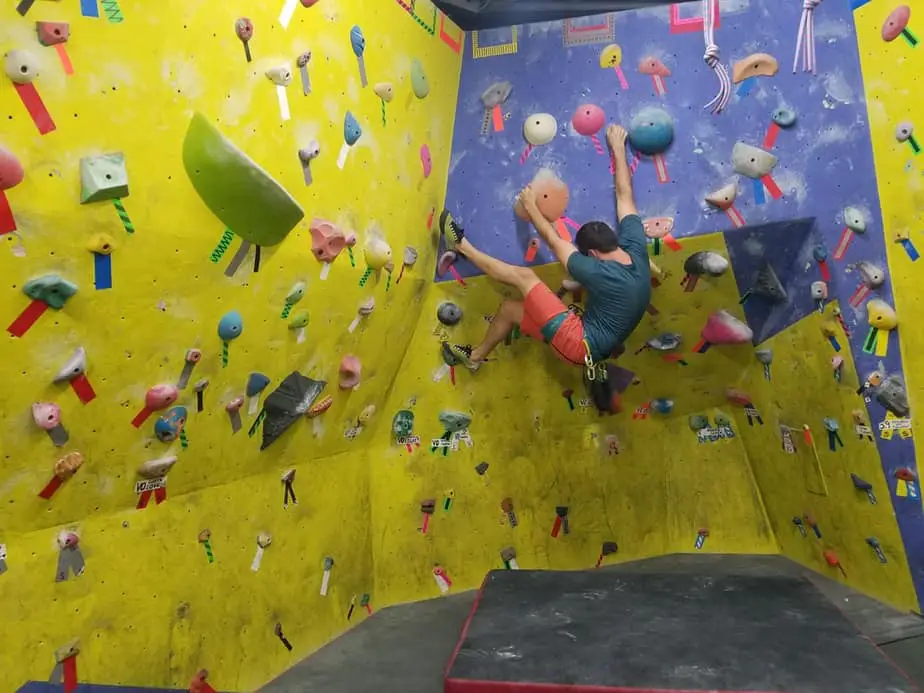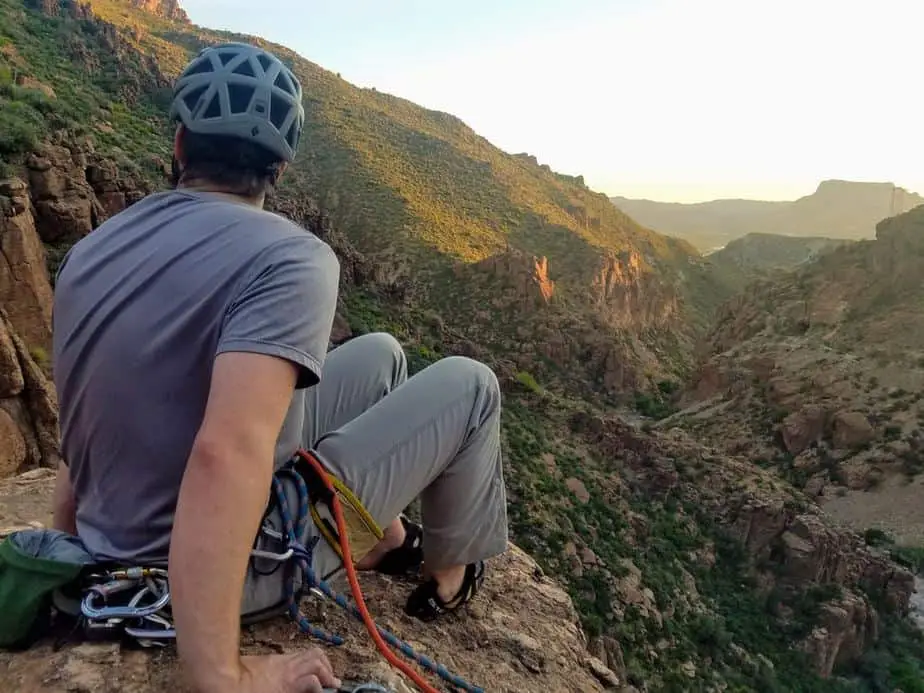Indoor rock climbing gyms are already expensive enough, plus they want you to rent or buy special gear and equipment. A harness is definitely a must for any climbing gym with roped walls (not for bouldering), but do you need special shoes?
Climbing shoes make difficult rock climbing possible with sticky rubber, sharp edges, and enhanced strength. Climbing routes of lower difficulty can be done in regular shoes, but it is less safe and much more difficult.
For all but the most basic rock climbs, climbing shoes are essential. They help keep your feet from slipping off small holds, and help balance the weight of your body onto your toes. Climbing shoes are key to the sport.
Why Are Climbing Shoes So Important?
Sure, most gyms do allow you to climb with tennis shoes or sneakers, but you’ll be handicapped by your feet and stuck on the biggest holds. Outdoors good climbers can probably climb up to a 5.9 or so in good approach shoes (see below for more info on approach shoes). In order to do any significant climbing though, you absolutely need real climbing shoes.
Think about going running in flip flops, playing basketball in high heels, or hiking in ski boots. While you might make it a little ways if you are stubborn, you will be miserable and can damage your feet. The right footwear for the activity not only boosts your performance level, but also protects your feet.
This is especially true with climbing shoes. When rock climbing emerged as a separate discipline from traditional mountaineering, climbers realized that they needed something different from clunky leather boots with nails hammered into the soles.
Modern shoes have been specifically engineered and designed by rock climbers for rock climbers. While there have been lots of advances in climbing shoes over the past 50 years, the fundamental idea remains the same.

How Do Climbing Shoes Work?
Climbing shoes consist of a rigid sole that provides a platform for climber’s feet, sticky rubber that grips rocks and plastic, and sharp edges that can support the climber’s weight on tiny holds.
Rigid Soles
Unless you’re also a ballet dancer and can execute a flawless pirouette, you probably can’t lift your whole body weight on your big toe. A lot of the climbing footholds you’ll encounter are barely big enough to fit a toe on, let alone the ball of your foot.
Climbing shoe soles consist of a single piece of rubber that goes from the tip of your toe to the middle of your foot. This provides structural support for your foot, extending toeholds out to the ball of your foot. It makes it a lot easier to climb on small holds and requires less foot strength.
As climbers advance, they tend to move towards soles that are less stiff or rigid. They do this so that they can feel the rock better, and so that they can strengthen their feet. Rigid soles make it so you can put your whole weight on the toe of one shoe.
The sole only goes to the middle of the foot so that it can be replaced, since that is the part of the shoe that is most likely to wear out. It is also the stickiest rubber on the shoe.
Sticky Rubber
When you look at the sole of a pair of climbing shoes, you’ll notice that there is no traditional ‘grip.’ The plain soles are almost reminiscent of bowling shoes, with absolutely no lugs or tread. The secret to climbing shoes is the rubber.
I always imagine climbing shoe-makers gathered around a big cauldron chanting and pouring in secret ingredients in order to make magic rubber that sticks to the walls. It probably looks more like a bunch of people in lab coats, but the result is just as mystical.
Climbing shoe rubber has to be the perfect balance between stiffness and stickiness. They need to be durable enough to grind up against rocks every day, but soft enough to grip slabby granite without visible weaknesses.
Climbing shoes are flat on the bottom rather than having any tread so that you can maximize the surface area of the rubber against the rock. Slippery rock slabs like granite and basalt can be very difficult to climb, so the increased surface area of the rubber helps grab on.
As an illustration, imagine climbing a ladder with hard plastic soled shoes on, versus climbing a ladder with bare feet. Bare feet contour around the ladder rungs and help you hold on, while hard plastic slides right off. Climbing rubber works similarly, while protecting and strengthening your feet.

Sharp Edges
Another defining feature of climbing shoes is the sharp edges around the toe box. The sharp, rigid edges of the soles of the shoes make it so you can climb on the smallest ledges and divots in the rock. Coupled with the the rigid soles, this makes it so all of your body weight can press down on one small area.
More advanced shoes have a slightly different angled toe, pointing downwards instead of straight out like a regular shoe. These aggressive shoes are better for more difficult routes, shifting the angle of your feet even farther downwards.
Over time and with use, the edges of climbing shoes wear down. What was once a sharp edge becomes rounded, and they are no longer as effective. At this point, they should either be thrown out or re-soled.
Heel Cups
The other really nice feature of climbing shoes is the rubber heel cup. Some climbs require the climber to stretch up and “hook” a hold with their heel, using their legs to lift them. Any regular shoe wouldn’t work for this. Climbing shoes have a rubber heel cup so that you can even grip the rock with the back of your foot.
Safety
These features of climbing shoes help make climbers more safe. The most dangerous part of climbing is probably when you take an unanticipated fall, which is common when you don’t have good shoes.
Normally a climber recognizes that their foot or hand isn’t going to hold, and has time to prepare for a fall and warn the belayer. With non-climbing shoes (soft foam or rubber soles), there is very little warning before you blow a foothold. When you blow a foothold unexpectedly, you fall a few feet and can scrape your legs on the wall.

Rock Climbing Without Climbing Shoes
If you’re going climbing for a kid’s birthday party or are going with a big group of people outdoors (scouts comes to mind), then you can probably skip the shoes. If you intend to only climb beginner routes and don’t really want to challenge yourself, you can make regular shoes work for a day.
Climbing gyms usually only charge $3-$5 for a shoe rental though, which is absolutely worth it to me. If you decide you like it, you can pick up a cheap pair of beginner climbing shoes for under $50.
For my recommendations, see my article: How Much Are Rock Climbing Shoes?
What are the best non-climbing shoes to climb in?
If, for some reason, you can’t climb in climbing shoes, you should put some thought into the shoes that you do decide to wear. Pick shoes that have similar characteristics as described above, with rigid soles. Wear tight shoes that your toes go all the way to the end of.
The best option would be Approach Shoes. These are designed for extreme hiking and approaches to climbing areas that require scrambling. My favorite ones are made by Adidas, in the Terrex Family. I top rope with them up to about the 5.9 range.
are made by Adidas, in the Terrex Family. I top rope with them up to about the 5.9 range.
Related Questions
Do Climbing Shoes Make a Difference? Climbing shoes are critical for rock climbing anything above the beginner range. They also make climbing more safe, and more fun. They are designed to strengthen climber’s feet and extend tiny footholds, making rock climbing possible.
What Shoes are Good for Climbing? There are specific shoes engineered for rock climbing; however if they are unavailable you can use other shoes and still be okay, though you won’t have as much fun. Wear shoes with rigid, rubber soles that fit your feet very snugly.
How Important are Rock Climbing Shoes? Rock climbing shoes are essential for moderate to advanced climbing. Without them it would be extremely difficult to climb on small holds and there is a heightened risk of slipping and falling. Climbing shoes make climbing safer and more fun.

